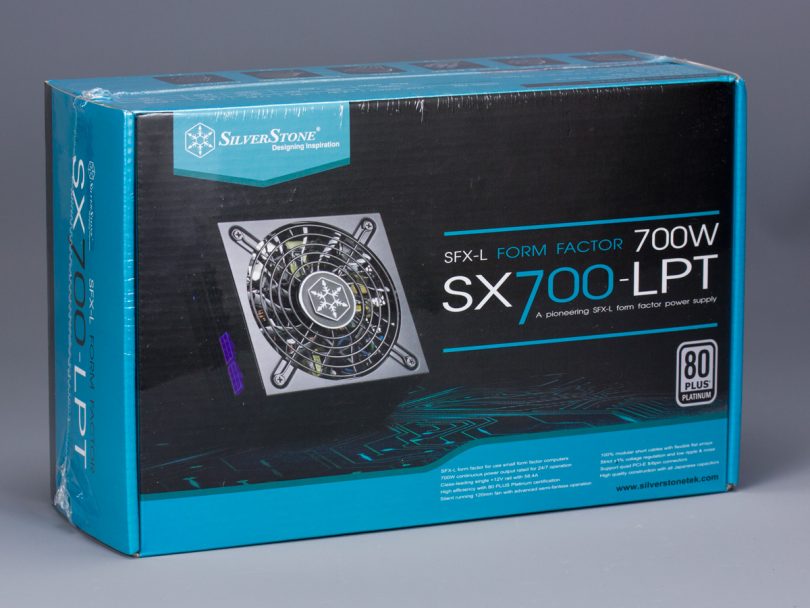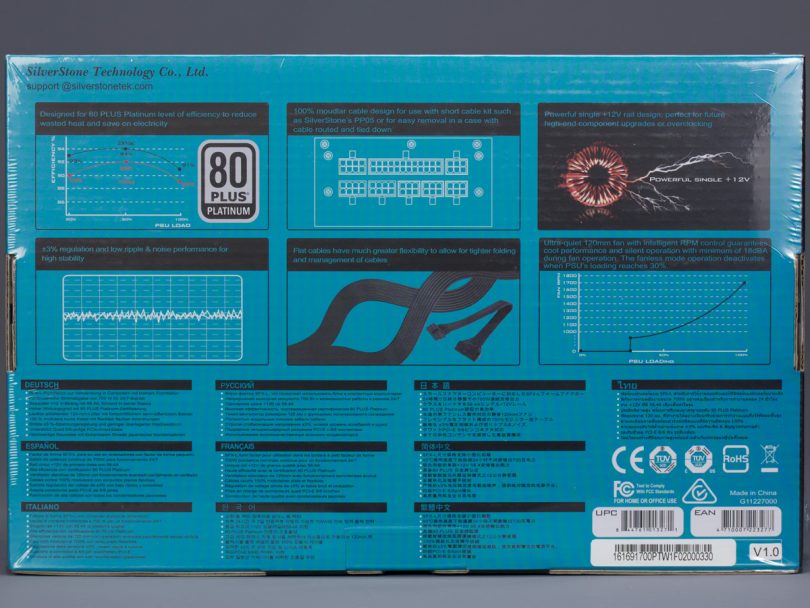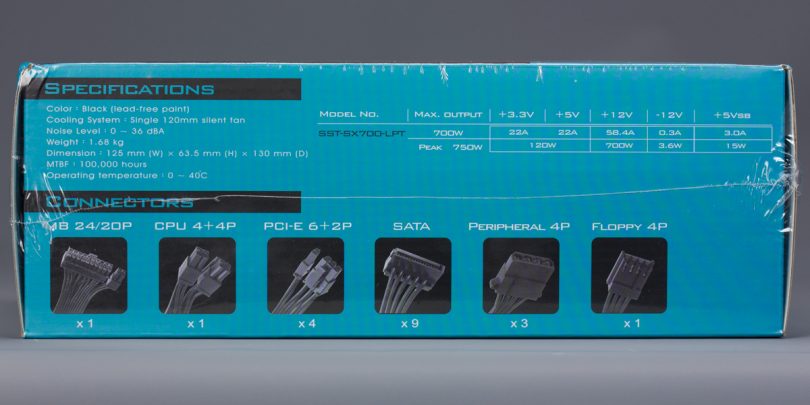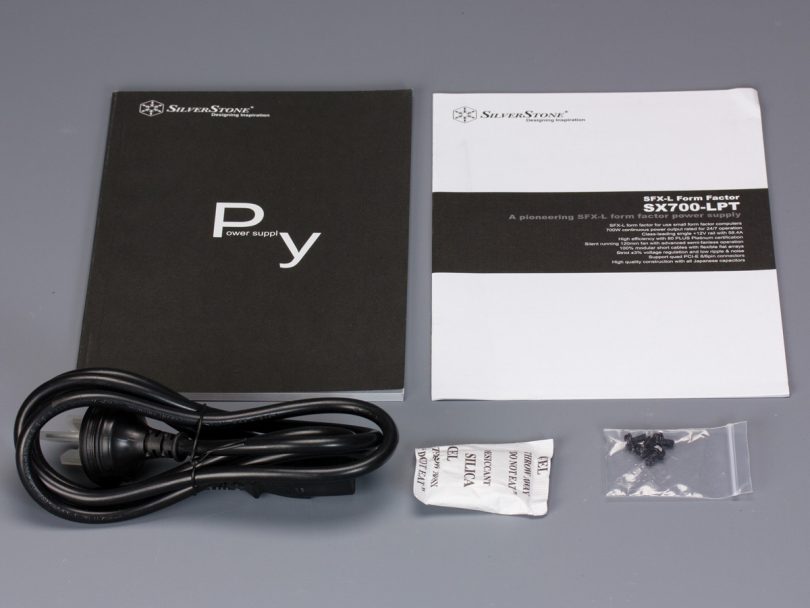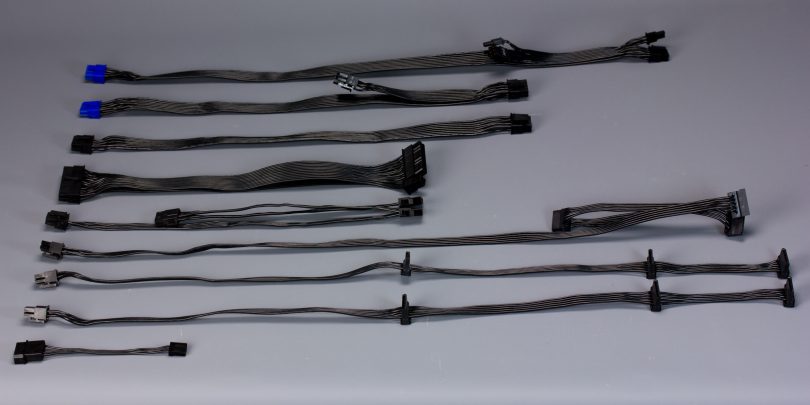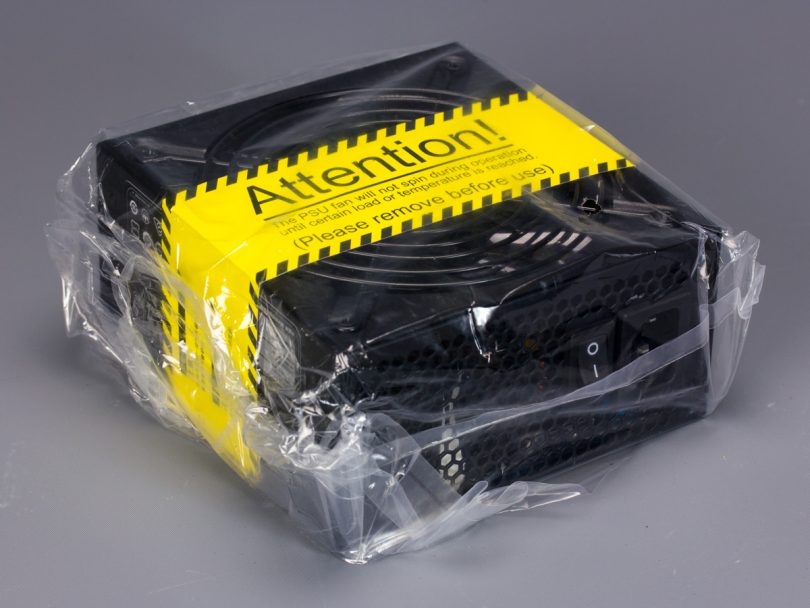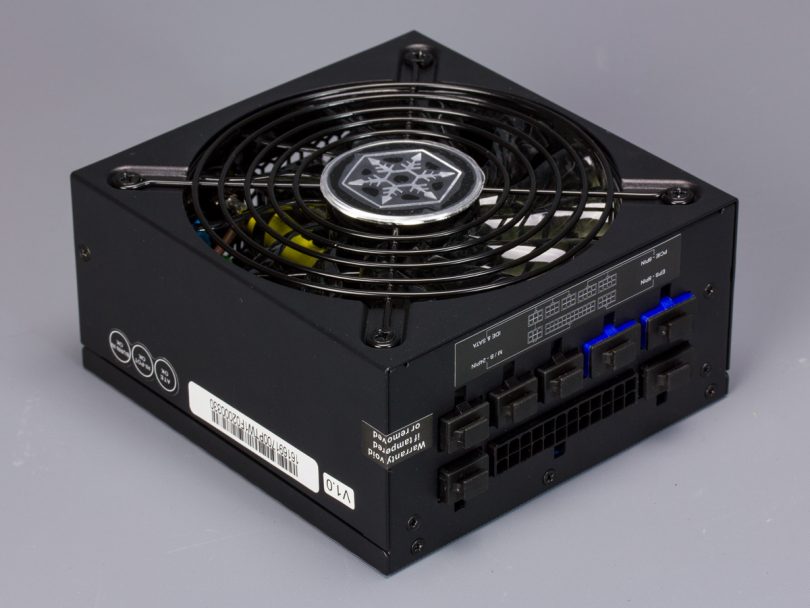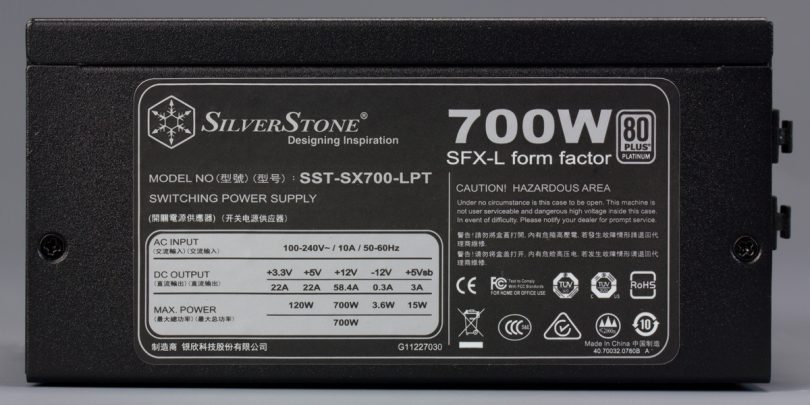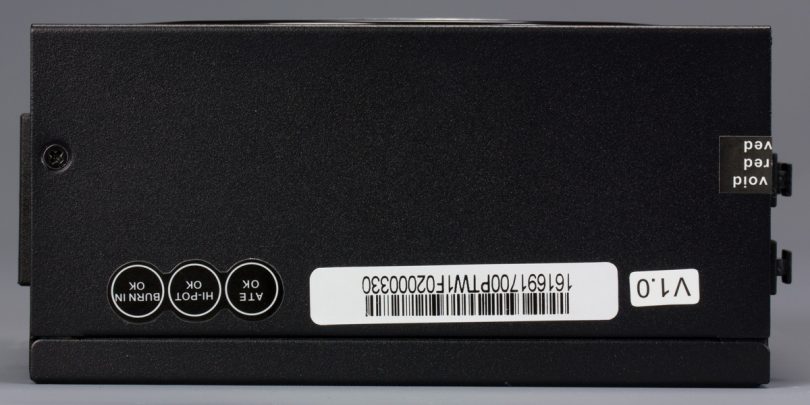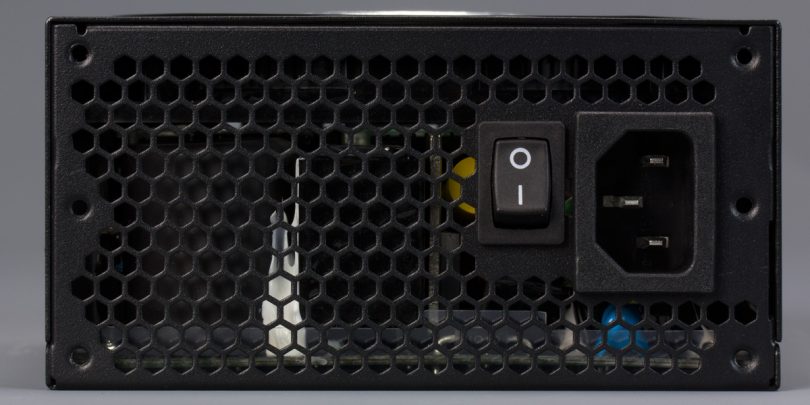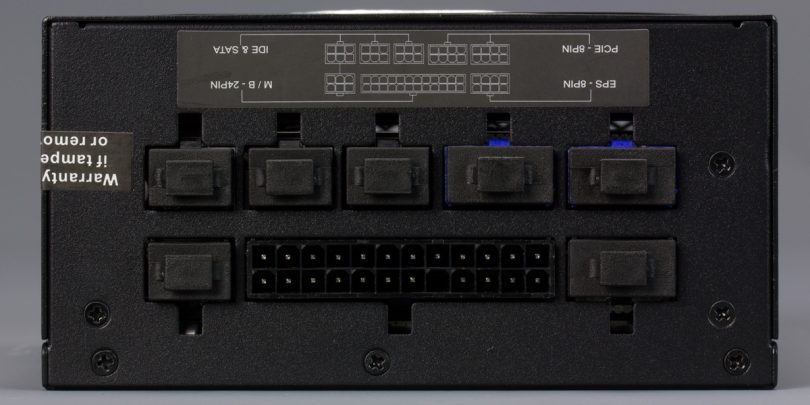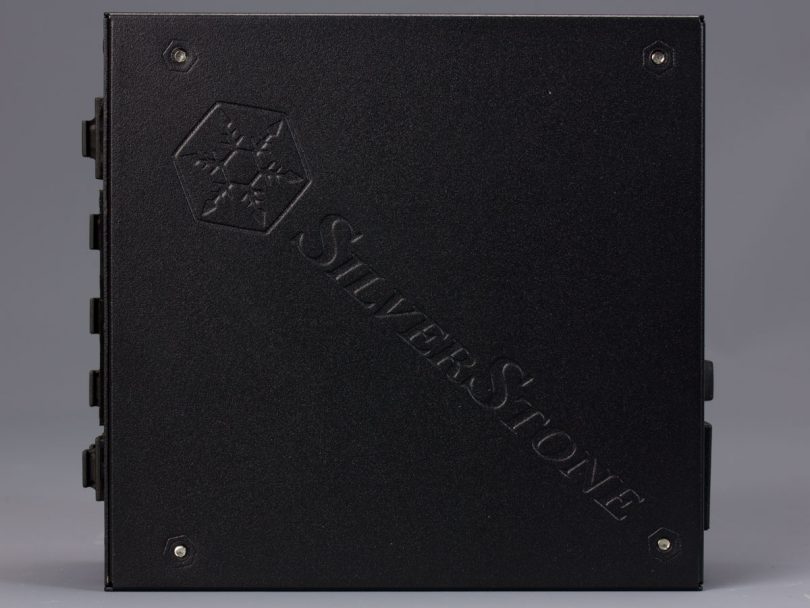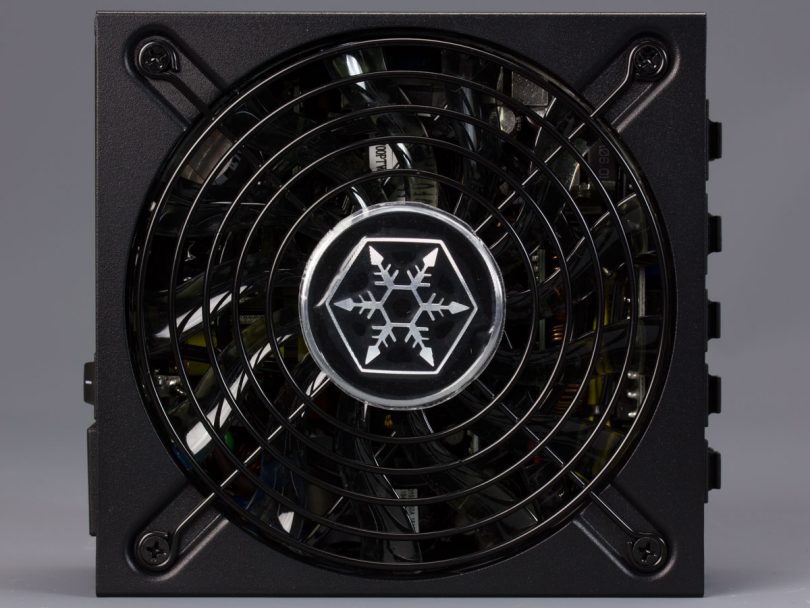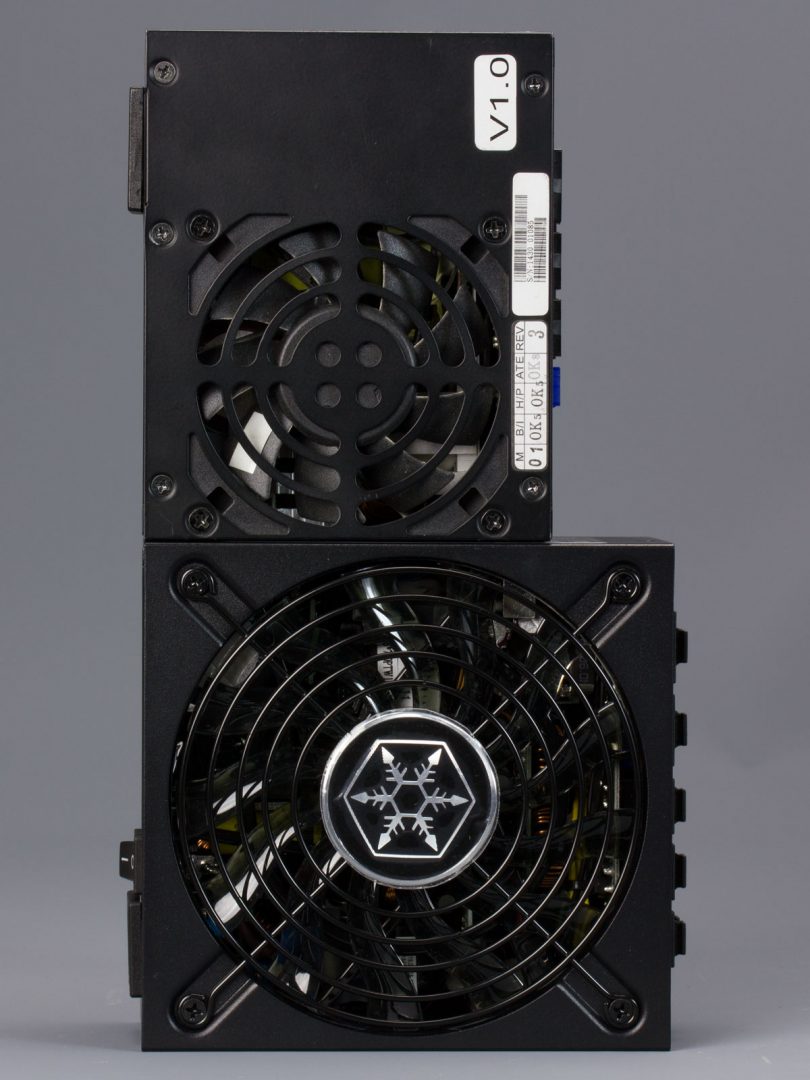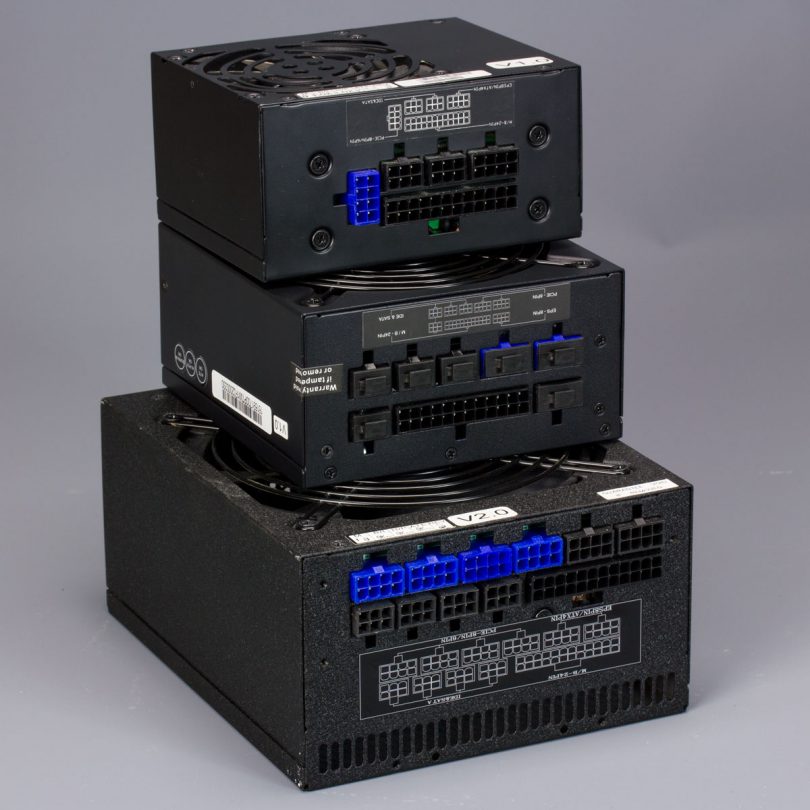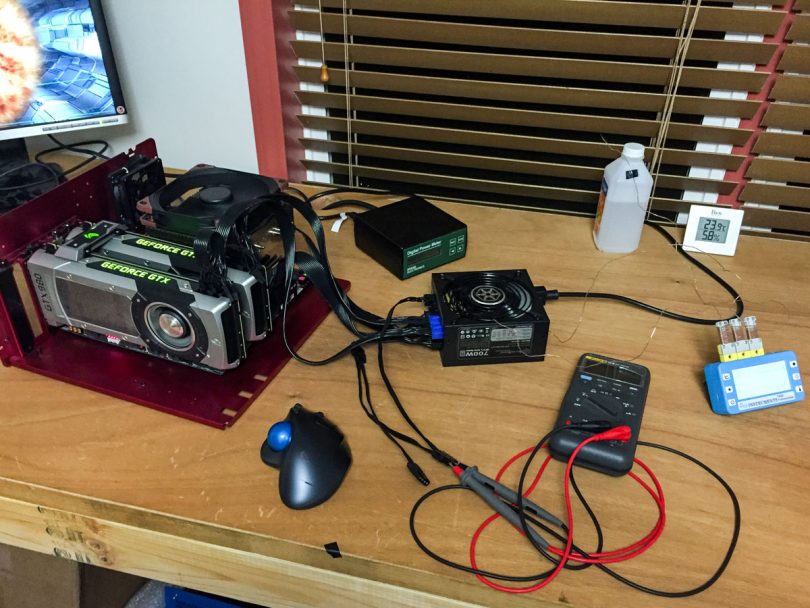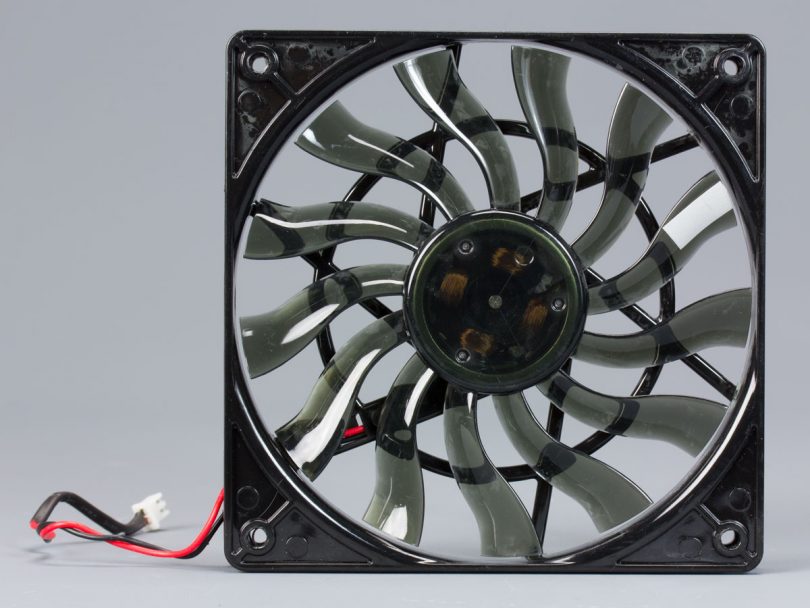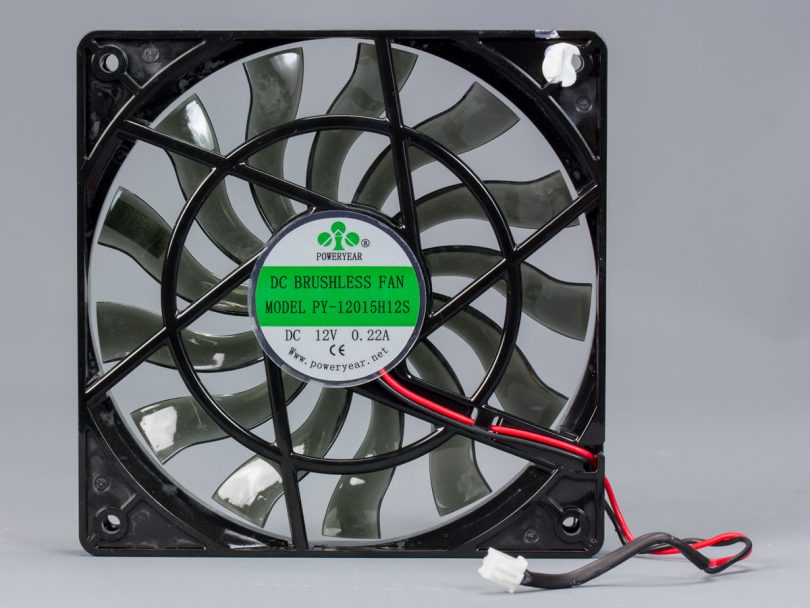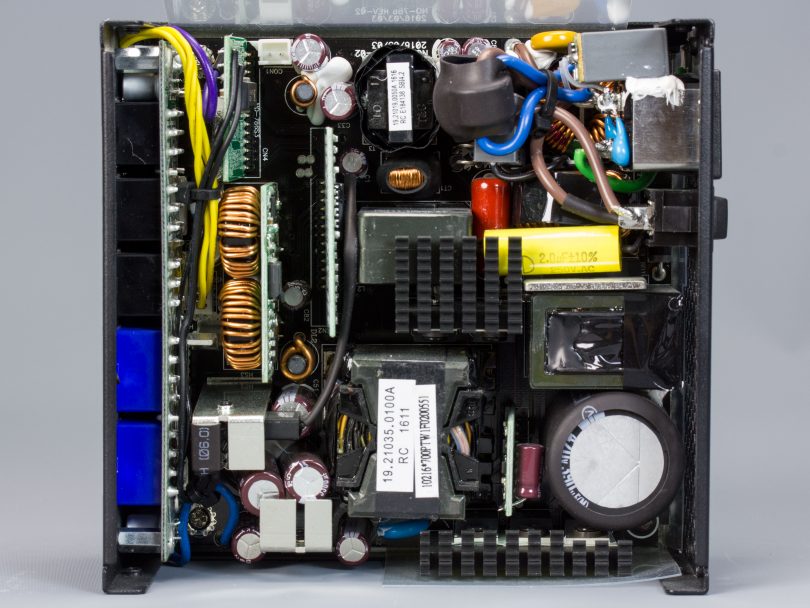This review has been a long time in the making.
The SilverStone 700W SFX-L power supply – that later came to be designated the SX700-LPT – was first shown off ahead of the last Computex on May 27th, 2015, almost exactly a year ago. Since then, the PSU has made appearances at various industry conferences and events, as if to tease us. But now, the time has finally come, and the SX700-LPT is here!
So what exactly is the SilverStone SX700-LPT? To explain this, I’d like to break down the model number because it contains the information we need, I’ve seen some confusion online regarding the new SilverStone PSU naming scheme, and I’ll be referring to the other comparable SilverStone units in this review by their model number often.
SX700-LPT: The SX denotes this is a SFF power supply.
SX700-LPT: This is easy, the number in the middle is the rated wattage.
SX700-LPT: The L means that this is a SFX-L form factor unit as opposed to a SFX unit.
SX700-LPT: The PT at the end means this unit is rated 80 Plus Platinum for efficiency.
So the SX700-LPT model number means this is a SFF PSU (in particular the SFX-L form factor) that is rated at 700W with Platinum efficiency, and it has fully modular cables.
Two notes: It’s not explicitly stated in the model number, but the current SilverStone convention seems to be that if the letter/s for efficiency are in the model number then it is also fully modular (the upcoming SX550 is Gold-rated but not modular). Also, the older SilverStone SFX units use a different naming scheme but we’ll ignore them for simplicity since they’re not competitors to this unit.
With this knowledge of the naming scheme, we can deduce that the SX600-G is a 600W SFX unit with Gold-rated efficiency and fully modular cables. The SX500-LG on the other hand is a 500W unit of the SFX-L variety, but also Gold-rated and fully modular.
Ok, with that out of the way on with the review! A quick disclaimer first before we get started though: SFF Network does not currently possess the expertise or equipment to fully test the electrical performance of PC power supplies, and as such this article should not be the sole data point in determining whether to purchase this product. Even so, our own experience and methodologies should speak towards those readers who are interested in the unit, and plan to incorporate it into similar builds.
The Box
The box for the SX700-LPT has a sharp-looking blue and black theme, that I think looks much nicer than their previous box designs.
Coming around to the back of the box is some marketing. Of particular interest to me is the tidbit that indicates that the fan should stay off up to about 30% utilization, and should still be below 1100 RPM at ~50% load.
On the top of the box, there’s some technical details. As mentioned on the back, this is a single-rail design, and the full 700W is available on the 12V. The number and type of connectors is suitable for a 700W PSU as well, though I question why a PSU that will presumably end up in a Mini-ITX or mATX case needs nine SATA connectors.
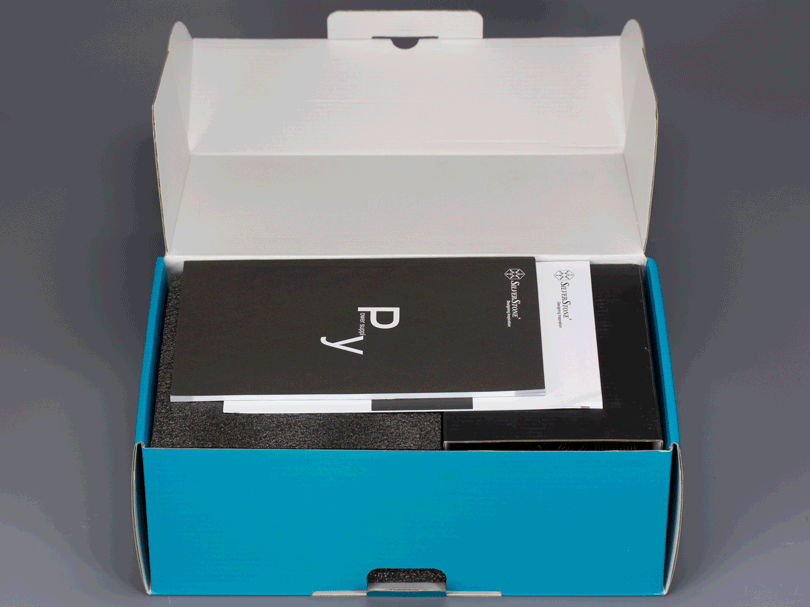
Opening up the box reveals some paperwork, cabling, and the PSU itself resting snugly in a block of closed-cell foam. Unfortunately, the SX700-LPT doesn’t come with any kind of bag or pouch to store the unused modular cables.
Fully modular cables are especially useful for SFF builds, since only the necessary cables are installed (and thus taking up space inside the case), but one of the big problems with removable cables is that they have a tendency to get misplaced. I’m a big fan of cable pouches, and for that reason, so I’m disappointed a flagship product like this didn’t come with one.
Accessories
The included accessories are fairly minimal, consisting of a general SilverStone power supply guide, a SX700-LPT manual, mounting screws, and a power cord. As a note, this particular unit was shipped to me directly from the SilverStone China office, hence the non-American power cord.
Like Corsair did with the SF600, SilverStone has opted to not bundle an ATX to SFX adapter bracket. I’m a bit torn on this, because I can see both sides of the argument for whether to include the adapter. Not including it means that those who want to use the PSU in a case intended for ATX units have to buy an additional part at extra cost… but bundling it unnecessarily raises the price of the PSU for those using the product as intended. Either way, there’s a sound philosophical reason behind that choice.
Cables
The SX700-LPT cables are the same flexible, ribbon-style cables that come with other newer SilverStone SFF power supplies.
Interestingly, the cable lengths listed on the SilverStone site are actually incorrect as of the time of writing, when compared to what we received in the box. Here are the lengths between connectors from top to bottom:
2x 6+2-pin PCIe (500mm / 150mm)
2x 6+2-pin PCIe (400mm / 150mm)
4+4-pin CPU (400mm)
24-pin motherboard (300mm)
3x 4-pin Molex (300mm / 200mm / 200mm)
3x SATA (600mm / 100mm / 100mm)
3x SATA (300mm / 200mm / 100mm)
3x SATA (300mm / 200mm / 100mm)
1x Floppy adapter (100mm)
(The first number is from the PSU-side to the first connector, and the second number is from the first connector to the second, etc.)
Having one of the PCIe cables longer than the other is a nice touch because, other than a few enthusiasts cards like the EVGA GTX 980 Ti KINGPIN, the vast majority of video cards have a maximum of 2x power connectors. This means that the primary use of the second PCIe cable on this PSU would be for a second video card in a mATX or ATX build, where one of the video cards would be further away from the PSU than the other (at least in typical case layouts).
A floppy power adapter is inclulded, and it can be argued that they’re still used for things like sound cards and fan controllers, but considering this is a PSU intended for the SFF market, I think it would have made more sense to bundle a slimline SATA power adapter for slim optical drives instead. That said, at least the floppy connector is split out into a separate adapter, instead of being part of the Molex strand like previous SilverStone units.
Overall, I’m pretty happy with the number and type of connectors, and the cable length. The SATA cables are maybe a bit on the long side, but of all the cables, angled SATA is the easiest to cut to length, since the connectors just press onto the wire – so I don’t think it’s a problem.
The Power Supply
The SX700-LPT comes wrapped in a plastic bag, as well as a prominent paper band warning the user that the fan not spinning under low load is normal. While I wish the SilverStone came with a pouch for the cables like the Corsair SF600, I’m glad SilverStone didn’t waste money on a fancy drawstring bag for the PSU itself, because that’s just silly.
With a quick look at the PSU, it becomes clear what the advantage of the extra housing length that gives SFX-L units their name is: the extra room allows for a 120mm fan, instead of the 92mm fans that SFX units are limited to. The height and width are the same as SFX, at 63.5mm and 125mm respectively.
Also visible here are the modular connectors, which are recessed into the housing a bit more than they were on the SX500-LG. The modular connectors on the SX700-LPT stick out 2.1mm from the housing.
I quite like this trend because every bit of space counts in a SFF build, and that could mean the difference on whether the cables press against the back of the video card in an NCASE M1 or not (as an example). Also of note (and visible here) are the covers for the unused connectors.
On one side of the unit, we have a label with the load table, warnings, and safety certifications. While certainly not the worst example of Engrish in the PC industry, the warning sticker could have benefited from editing by a fluent English speaker before the unit went to production: “Under no circumstance is this case to be open. This machine is not user serviceable and dangerous high voltage inside this case. In event of difficulty. Please notify your dealer for prompt service.”
The other side is pretty plain, with just stickers for the QC tests, a serial number, a revision number, and one-half of the warranty void sticker (which may or may not survive this review).
For this PSU, I’d recommend caution if using non-standard screws for mounting it to the case. There’s a plastic shield to protect the PCB, but a longer than normal screw could still potentially cut through it and contact the circuit board. What I usually do when installing SFX or SFX-L PSUs is to use just the middle 2 screw holes if possible, if only to completely avoid the issue.
Moving to the remaining side, we see the modular connectors and get a good look at the little plastic connector covers. I think this is a great idea because I could see where, in a cramped SFF build, there’s the possibility of a stray wire or connector coming into contact with one of the unused PSU connectors and causing a short. An example that comes to mind is the NCASE M1, because the end of a SFX-L power supply is right above the backside of a long video card in that particular chassis.
If the video card only has 6-pin power connectors, that would leave the +2 connector on the cable sitting loose in close proximity to the PSU connectors – and while very unlikely, I could see that 2-pin connector getting accidentally pushed into one of the PSU connectors while working in the case. Needless to say, that would not be a fun time.
SilverStone carried over the wire grill from the SX500-LG, and I’m happy to see it because a wire grill is typically less restrictive to airflow when compared to stamped vents in the metal housing.
This picture demonstrates the difference between SFX and SFX-L, or 100mm of length versus 130mm. While the SX700-LPT actually has a lower Watt/Liter figure compared to the older SX600-G, the extra room allows for better cooling as well, which will hopefully result in significantly quieter operation.
While SFX-L is 30% longer than SFX, the height and width stay the same, so it’s still substantially smaller than an ATX unit.
Testing
As mentioned at the beginning of the review, we currently lack the expertise and equipment to properly evaluate the electrical performance of power supplies to a complete extent, so the following data is more to demonstrate that the SX700-LPT is capable of powering the test system with no issues.
Test hardware:
| CPU | Intel Core i7-5930K |
| Motherboard | Asus X99-M WS |
| Cooling | Noctua NH-C14S with black NF-A14 PWM |
| PSU | SilverStone SX700-LPT |
| RAM | Crucial Ballistix Sport 16GB (4x8GB) DDR4 2400 |
| Video Card | 2x EVGA GTX 980 reference |
| Storage | Intel 750 400GB |
| Case | Lian Li PC-6X tray |
| OS | Windows 10 64-bit |
Test equipment:
- Brand Electronics 4-1850 power meter, used to measure the AC draw of the system.
- Reed AT-6 non-contact tachometer, used to measure the fan RPM (this is also the reason for the reflective sticker stuck to one of the fan blades in some of the pics).
- Pax Instruments T400 temperature datalogger, used to measure ambient, intake, and exhaust temps. Now with Omega thermocouples.
- Fluke 83 III multimeter to measure voltage.
Methodology:
Each test is run for 10 minutes, and then readings are taken before moving on to the next test. Both video cards were installed for all tests, but on the fourth test SLI was disabled and FurMark was run on a single GPU. For the last test, SLI was enabled and FurMark was run on both.
Test Results:
| Wattage (AC) | Ambient Temp | Intake Temp (delta) | Exhaust Temp (delta) | Fan RPM | 12V | Notes |
| 75W | 23.5°C | 36.7°C (13.2°C) | 29.6°C (6.1°C) | 0 | 12.20V | Idle |
| 105W | 23.2°C | 38.8°C (15.6°C) | 27.6°C (4.4°C) | 0 | 12.20V | 2 threads of Prime95 Blend |
| 180W | 23.4°C | 43.0°C (19.6°C) | 30.1°C (6.7°C) | 0* | 12.20V | 10 threads Prime95 Blend |
| 350W | 24.1°C | 26.5°C (2.4°C) | 31.9°C (7.8°C) | 620 RPM** | 12.19V | 10 threads Prime95 Blend, FurMark 1x 980 720p no AA |
| 485W | 24.3°C | 26.0°C (1.7°C) | 31.5°C (7.2°C) | 1180 RPM | 12.18V | 10 threads Prime95 Blend, FurMark 2x 980 4K 4x AA |
*Fan spun for a few seconds at the start of the test
**Fan started at 1520 RPM but quickly settled down to 620 RPM
As expected, I had no issues powering a Haswell-E processor and SLI GTX 980s at full tilt.
Fan
The fan blades and frame look identical to the fan used in the SilverStone SX500-LG. It has a 120mm x 15mm frame, and 13 blades.
Unlike the SX500-LG, the fan in the SX700-LPT bears the name PowerYear and the model number PY-12015H12S. According to SweClockers though, despite saying Globe Fan on the sticker on the fan in the SX500-LG, it is actually a PowerYear with this same model number as well, except with a different rated amperage. Either way, there is no information online about this fan that I could find.
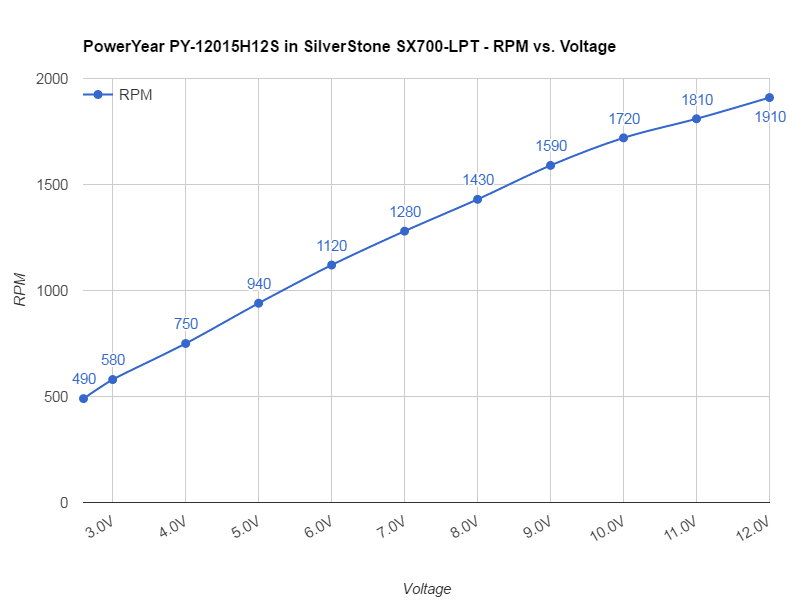
Since there is no information to be had from the manufacturer or anyone else, I tested the voltage/RPM fan curve myself. The fan’s starting voltage is 2.6V, and from there it’s a fairly flat curve up to the max RPM of 1910 RPM at 12V. The fan exhibits no strange behavior at the starting voltage, once it gets to 2.6V it starts up and that’s it. No squealing or other oddities like the SX600-G, either, which was welcome – though I did notice a slight rasping noise when the fan spins down to a stop.
Fan Controller
Previous SilverStone SFF power supplies with semi-fanless functionality rely on simplistic temperature-based controllers that, in my experience, have trouble actually keeping the fan off even when the computer is idling. To address that deficiency, SilverStone has switched to a load-based fan controller for the SX700-LPT. This system bases the fan RPM off the current load level, with secondary input from temperature sensors that are supposed to ensure the unit stays cool if the internal temperature gets too high regardless of load.
With the system idling at 60W (measured at the wall) and 21°C ambient, the fan controller voltage was at 0.06V. Increasing the load to 115W increased the voltage to 0.09V, and 180W load resulted in 0.12V. Bumping up from 180W to 345W, things start to get interesting. The fan voltage suddenly increases, and I found it to quickly fluctuate back and forth between 3.1 to 3.8V. Although the multimeter was picking up fluctuations in the voltage, the tachometer registered a stable 600 RPM during this test, so while I’m not sure what’s going on with the fan controller for the voltage, it’s not causing the fan to constantly surge in speed.
When I closed FurMark after that test in order to turn SLI on for the final test, I noticed the fan controller voltage almost immediately dropped to 0.12V, and consequently the fan turned off. This is a big improvement over the fan controller behavior on the SX600-G and SX500-LG. The simple temp-based controllers in those units directly tied the fan voltage to the temperature of an internal thermistor. Thus, what would happen is that after the load lessened, the voltage would slowly drop as the unit cooled down – but often not enough to get below the fan’s starting voltage and so the fan would never shut off once it started. Here, though, once the load drops below its cutoff threshold, the controller drops the output voltage well below the fan’s starting voltage, to make absolutely sure the fan shuts off.
With the final test at 480W, the fan voltage jumped to 5.0V at the start of the test, and by the time 10 minutes had elapsed, it had settled at 5.3V. Unlike the previous test, though, the voltage was stable with no strange fluctuations. After closing Prime95 and FurMark, the fan stayed at 5.3V for about 5-6 seconds, and then dropped to 0.12V.
I did run into one oddity with the SX700-LPT fan controller, though, when I was running some additional tests. At one point, I had just Prime95 running with 10 threads, for about 190W load, and had left it for about 15 minutes. When I came back to the test bench, the fan was twitching off and on as if it was right at the fan’s starting voltage. Like previously mentioned, though, this fan starts cleanly with basically no transition period, and it turns out that it was the fan controller fluctuating between 0.2V and 2.9V. So while I’m very happy with the behavior of this load-based controller when compared to previous SilverStone units I’ve tested, there is still room for improvement, with perhaps some hysteresis needed at the controller’s fan on/off threshold.
I didn’t test it extensively, but the fan controller does take temperature into account as well when determining what RPM to run the fan at. To test this I ran the system at full load and then used a heatgun pointed at the PSU’s intake to quickly raise the temperature of the intake air. When doing this, the fan RPM increased in speed and then dropped back down to the previous RPM level after I turned off the heatgun.
Noise
After the Corsair SF600 review, I looked into what it would take to accurately and objectively measure fan noise for these PSU reviews, but to do it properly is well outside of my test equipment budget for the foreseeable future. So once again it’ll just be my subjective evaluation.
Overall, I’m very happy with the SX700-LPT’s noise levels, especially in comparison to previous SilverStone power supplies, and even the new Corsair SF600. As mentioned in the fan controller section, one of my biggest frustrations with the noise levels of the SX600-G and SX500-LG is that they both rarely ran in passive mode after the system had been running for more than 10 minutes. The fans on both those units had other issues, but it’d be much more tolerable if the fans weren’t running at idle, which didn’t happen. With the SX700-LPT, the semi-passive functionality is pretty much solved. The new load-based controller has no issue keeping the fan off at low loads, and once the fan does turn on, it will quickly shut the fan off once the load drops.
The fan controller can end up in a transitional state where it causes the fan to “twitch”, but this does not result in any squealing, clicking, clacking, or other strange noises, so I’m not too concerned about it.
Speaking of strange noises, I did experience some electrical whine/buzzing with my unit that was audible at close distances. But to be clear, this is NOT necessarily an indication that the SX700-LPT model suffers from coil whine. Specific power supplies can exhibit coil whine in combination with specific hardware, so it’s possible I just got unlucky. Until these units get in the hands of a significant number of users, it is too early to say whether electrical whine is a common issue, I’m just reporting my findings on my particular sample.
For fan noise, I generally found the SX700-LPT to be better than either the current SilverStone or Corsair flagship SFX units, the SX600-G and SF600 respectively. This is due in large part to the slightly longer SFX-L form factor, which allows for a roomier interior and a larger fan. It is also due in part to the Platinum efficiency, since with less waste heat, less cooling is needed. The influence of both of these factors is immediately apparent in the measured fan RPM at the maximum load I could draw with my setup. At ~500W, the two SFX units are at about 2000-2100 RPM, compared to around 1200 RPM with the 700W. At max loads, the fan RPM is similar between the two SilverStone SFX-L units. For low loads, the 700W stays off for longer than any of the other 3 units, and it has the least aggressive fan curve up to 500W.
Really, my main gripe with the fan noise on the SX700-LPT is the bearing noise. This may be a total non-issue for some people, but I’m particularly sensitive to it. To me, it sounds very much like ball-bearing noise, though I’m pretty sure this fan uses sleeve bearings – the S at the end of the fan model number would seem to indicate as much, and the sticker on the SX500-LG version of the fan specifically says sleeve bearing. Regardless, this is one aspect where I prefer the Corsair SF600, since its fan uses rifle bearings and exhibited no bearing noise that I could hear. Not to say that’s the bearing noise is really bad, far from it, but it is definitely audible at low loads to me.
It could just be sample variation, though, as the Lian Li PE-750 that we’ve also been testing uses a PowerYear fan with the same model number as well, and it has the same bearing noise, just not as badly. It’s not the exact same fan, however, because although the model number is identical, the rated amperage and voltage/RPM curve is different between the two. So overall I’m simply not sure if the SilverStone version of the fan is more susceptible to bearing noise compared to the Lian Li, or if it’s just normal manufacturing variations.
Either way, bearing type is something I hope will improve in future SFX-L power supplies. Corsair did a great job by going with a rifle bearing in their custom fan for the SF600 and I really hope to see at least that, or better yet, a fluid dynamic bearing fan in the next generation of SFX-L units.
I won’t be discussing the relative noise performance between the SilverStone and Lian Li units here because there are some oddities with the fan controller behavior on the Lian Li that I want to go over first. The review of that unit, the PE-750, should be posted soon.
Internals
I’m not qualified to talk about the internal build quality, but I did notice that all the electrolytic capacitors I could make out were Nippon Chemi-con, that were at least 105°C rated. Nippon Chemi-con caps are Japanese, and are generally considered to be first-tier.
The OEM for the SX700-LPT is Sirfa/High Power, the same OEM for the SilverStone SX500-LG and all the other 500W SFX-L units that have been released up to now.
Conclusion
Before getting into my closing thoughts, I’d like to address the question: who is this product for? For the SilverStone SX700-LPT, this is a discussion that has come up very regularly in the comments under news articles, and in forum threads about this unit, over the past year.
In my mind, there are three “main” use cases for this unit: very high-end enthusiast Mini-ITX builds, SFF mATX or ATX cases with dual-GPUs, and noise freaks:
- A typical modern Mini-ITX gaming rig can run off a 450W PSU without breaking a sweat. But the power draw of an i7-5960X and GTX 980 Ti, both in a custom loop and heavily overclocked, can make even a 700W power supply not just a nicety, but a necessity.
- There isn’t much in the way of compact microATX or ATX cases that demand SFX/SFX-L power supplies on the market today, but with this PSU in their portfolio now, I expect it’s just a matter of time before SilverStone develops a case to take full advantage of it – and other manufacturers will hopefully follow suit. A dual-GPU workstation or VR rig on a mATX or ATX board can push even a 700W PSU to the limit.
- Finally, there’s those striving for a compact and quiet system who are willing to pay a premium for an over-specced PSU. By using a PSU like this, they can ensure that their computer will spend more time with the fan either off entirely, or at a lower RPM, when compared to a unit with a rated wattage closer to the actual power draw of the system.
Admittedly, those are all niche uses cases but in a sense SFF itself is a small niche within the computer hardware industry, so that it only appeals to a niche set of users is not a compelling argument against the existence of this product. There is a market for high-wattage SFF power supplies – the right question really comes down to whether it’s big enough to justify continued development in even higher wattages, higher efficiencies, and so forth.
So, all of that said, what do I think of the SilverStone SX700-LPT? It’s definitely the best SFF power supply SilverStone has developed so far: it’s the highest wattage, highest efficiency, has the most connectors, and is easily the quietest. Outside of SilverStone’s product line, the closest competitors are the 600W SFX Corsair SF600, and the (very) recently released 750W SFX-L Lian Li PE-750:
- The SF600 has less fan bearing noise, is cheaper, and has a longer warranty (7-year vs 3-year for the SilverStone), but much more fan noise at load due to the smaller fan having to spin faster. Additionally, the cables are comparably stiff and more difficult to work with.
- We’ll have a full review of it soon, but in short, the PE-750 is rated 50W higher, and is quieter at high load. However, it is noisier at low loads compared to the SilverStone, and only comes with a 2-year warranty.
As is typical for small form factor parts, there isn’t a clear-cut answer to which is the “best” product, as it’ll all depend on your needs and priorities. The SX700-LPT falls short of perfection, but it offers enough power for me to upgrade from SLI GTX 980s to dual GTX 1080 Ti’s (whenever they come out). Meanwhile, it’s quieter at low loads compared to the Lian Li, and comes with a decent enough warranty period. So as of now, at least, the SX700-LPT is my personal SFF PSU of choice.
The SX700-LPT’s MSRP is $150, and it should be available in NA within the next week or two.
Thoughts? Discuss them in the forum here.
Review sample provided by SilverStone.

